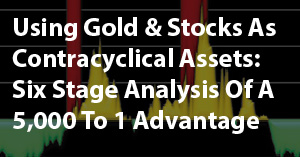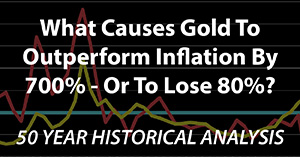Gold To Housing Ratio Methodology Notes
By Daniel R. Amerman, CFA
Gold To Housing Ratio or Housing/Gold Ratio?
The intent of this analysis is to be intuitively understandable for the average person. What is compared is how much gold is required to purchase an average home over time, and it can be described as either a Gold to Housing Ratio or the Housing/Gold Ratio.
The mathematical formula is to start with a median 2020 home price of $241,000 and divide it by the 2020 average annual price per ounce for gold of $1,770 - in other words Housing/Gold - to get the number 136.
The output of the formula is the easily understandable number of ounces of gold needed to buy an average home. If one could show up at a house closing with physical gold, then on average over the long term we would need to bring 218 ounces. Needing to bring 400 ounces to buy the home would be expensive, gold would be unusually cheap relative to housing. Needing to bring the current 136 ounces means that homes are unusually cheap relative to gold - common perceptions of the opposite being true notwithstanding.
The number is the amount of gold needed to buy a home, and it is described in that way, with the necessary mathematical path needed to get there being the inverse.
Methodology Notes For Gold To Housing Ratio
The source for inflation information is the Consumer Price Index for Urban Consumers (CPI-U), as provided by the U.S. Bureau of Labor Statistics (BLS).
For 1975-2020 the annual average London closing price for gold as reported by the Federal Reserve is used, with the Fed using Kitco as its own data source.
Obtaining timely and consistent national real estate statistics can be challenging relative to collecting information on securities such as stocks and bonds, for there is no daily closing price, and price change reporting may be delayed by months as the data is gathered. There are also the issues that where people live changes just a bit each year, as does the age, size and amenities of an average home.
Because what is an average home changes at least a bit every year, that means that we can't simply compare national average home prices, if we want isolate price changes for existing homes.
The standard is therefore to use a "pairs-based" methodology, where sales of the same home in different years are used to track real estate price changes, rather than changes in mean or median home prices. This does limit the historical database, with the Freddie Mac House Price Index used in this book going back only to 1975.
The "pairs-based" Case-Schiller index is the norm for media reporting of national housing price movements, however, the most commonly reported measure focuses only on the 20 large metropolitan areas, and these can exhibit very different price behavior than the rest of the country.
The Freddie Mac House Price Index used herein includes all 50 states, as well as the other 300+ metro areas, making it a much better national measure, and it is also based on a pairs methodology which accounts for changes in average home size and amenities over the years. But the national average index slightly changes each year, in a way that is retroactive for all the previous years on the basis of "geographic weighting", which likely primarily reflects estimated population shifts, although Freddie Mac won't release the methodology or the weights.
The index numbers are however just that, index numbers and not dollars. To translate to the dollar home prices needed to calculate the ratio, we need a "peg" in one year, a good solid number for the value of an average home in that year.
This "peg" for this analysis is the $225,000 median home price for owner occupied homes that was determined in the Federal Reserve's 2019 Survey Of Consumer Finances, which was released in September of 2020. This once every three years survey is considered to be a definitive source of consumer information for the United States.
To get the $241,000 median home price in 2020, the $225,000 median home in 2019 was adjusted for the increase in the Freddie Mac House Price Index between 2019 and 2020. All years prior to 2019 were also calculated starting with the "peg" of a $225,000 median value in 2019, and comparing the price indexes in each year.
Because it is a 2019 home, and is on average larger, has more amenities, and is in a more urban area than homes in previous decades, this means that it generates higher historical home values than what the actual averages were at the time for what were the smaller and more rural homes of the nation. Take an average home in 2019, put it back in 1975, and it would be an unusually nice home in a higher value area, so the value is higher than an average 1975 home, as it has to be if we are to isolate and track changes in the market values of existing homes.
















